Full Text Searchable PDF User Manual

10/29/14
System Operation Manual
E3 Path+, Venture, Detour
This manual is meant to be read together with the owner’s manual, also included with
your bicycle. The owner’s manual contains important safety and use information about your
bicycle. Be sure to read both manuals before riding for the first time, or performing any
assembly. If you did not receive an owner’s manual, the most recent version can always
be found online at www.CurrieTech.com.
1
/16
EBCC
Technical and Customer Service: +1 800-377-4532

2
/16
System Operation Manual - E3 Path+, Venture, Detour
10/29/14
Contents
Section 1
Electrical System Components . . . . . . . . . . . . . . . . . 4
Section 2
General information . . . . . . . . . . . . . . . . . . . . . . . . . . 8
Section 3
Basics . . . . . . . . . . . . . . . . . . . . . . . . . . . . . . . . . . . 10
Battery charging . . . . . . . . . . . . . . . . . . . . . .10
Charging procedure . . . . . . . . . . . . . . . . 10
Charge time . . . . . . . . . . . . . . . . . . . . 10
Checking the battery’s charge level . . . . . . . . 10
Using the battery . . . . . . . . . . . . . . . . . . . . . 11
Installing the battery . . . . . . . . . . . . . . . . 11
Removing the battery . . . . . . . . . . . . . . . . 11
Turning the bike on and off . . . . . . . . . . . . . 11
To turn the bike on . . . . . . . . . . . . . . . . . . . 11
To turn the bike off . . . . . . . . . . . . . . . . . . . 11
Section 4
Riding and use . . . . . . . . . . . . . . . . . . . . . . . . . . . . . 12
Getting ready to ride . . . . . . . . . . . . . . . . . . . .12
Riding the bike . . . . . . . . . . . . . . . . . . . . . .12
Using the motor . . . . . . . . . . . . . . . . . . . 12
Assist levels . . . . . . . . . . . . . . . . . . . . 12
Throttle . . . . . . . . . . . . . . . . . . . . . . . 12
Cruise control . . . . . . . . . . . . . . . . . . . . 13
Using the brakes . . . . . . . . . . . . . . . . . . 13
The display and control pad . . . . . . . . . . . . . . . .13
The display’s cyclecomputer functions . . . . . . . 13
The display’s electrical system functions . . . . . . 14
Assist level . . . . . . . . . . . . . . . . . . . . . 14
Battery level . . . . . . . . . . . . . . . . . . . . 14
Maintenance information . . . . . . . . . . . . . . 14
Control pad functions . . . . . . . . . . . . . . . . 14
Section 5
Troubleshooting . . . . . . . . . . . . . . . . . . . . . . . . . . . . 15
Error codes . . . . . . . . . . . . . . . . . . . . . . . .15
Charging issues . . . . . . . . . . . . . . . . . . . . . .15
Misc issues . . . . . . . . . . . . . . . . . . . . . . . .16
Lost key . . . . . . . . . . . . . . . . . . . . . . . 16
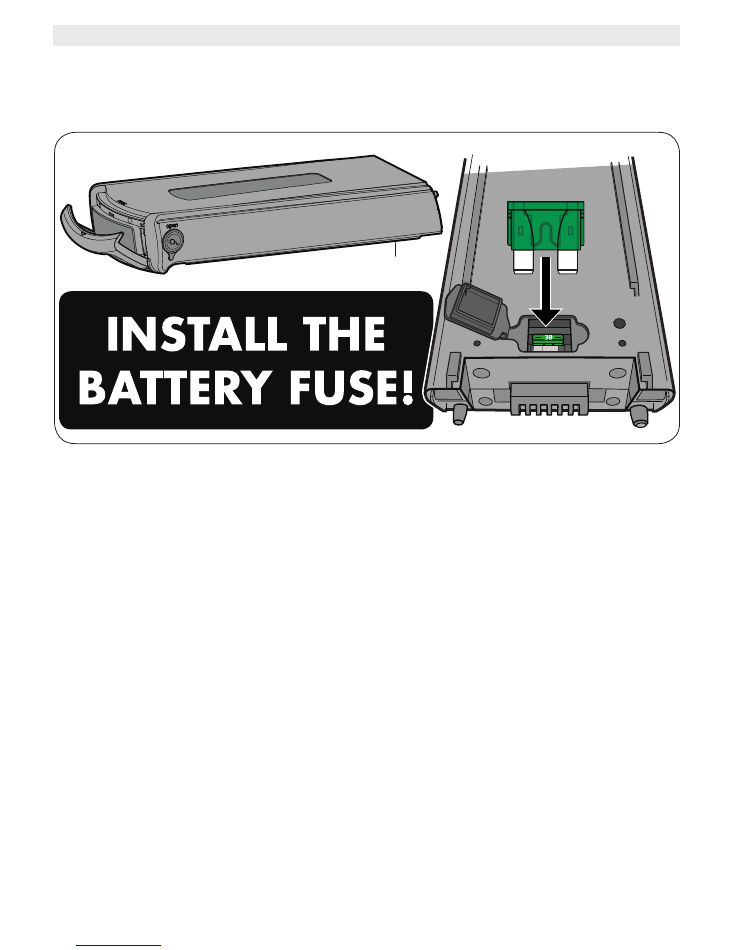
3
/16
System Operation Manual - E3 Path+, Venture, Detour
10/29/14
Notice!
Your bike ships without the battery fuse installed.
This helps keep the
battery in top condition during shipping and storage.
Before using your bike for the first
time
, you’ll need to
install the fuse
, as shown in the diagram above.
The fuse is in a small plastic bag, either hanging from the bike or in the parts box. It is a
standard 30-Amp automotive fuse.
Fuse
cover
30
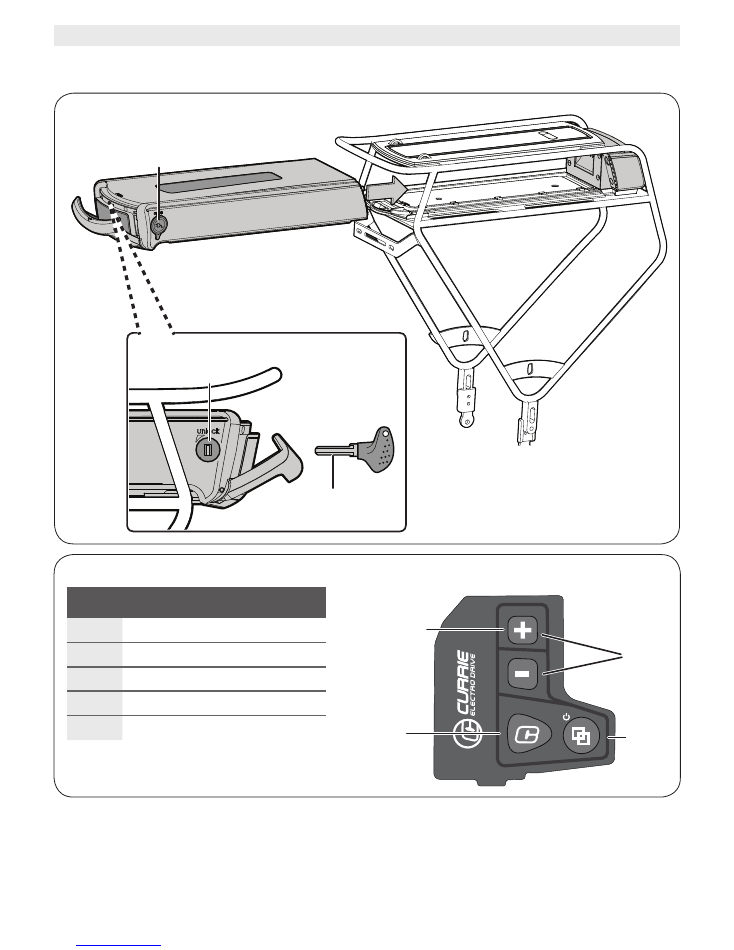
4
/16
System Operation Manual - E3 Path+, Venture, Detour
10/29/14
Control pad
CONTROL PAD BUTTONS
A
Assist level
B
Light
C
Power
D
Info
E
Cruise control
Battery and rack
Key
Battery
lock
Battery
charging port
Electrical System Components
DP12C
MY2015 M19:
Dash, Path+
Venture, Detour
DP12D
MY2015 M07/M35:
Peak, Peak DS, Sumo, Protour
Tekoa
A
B
C, D
E
Operational details, see p .12-14
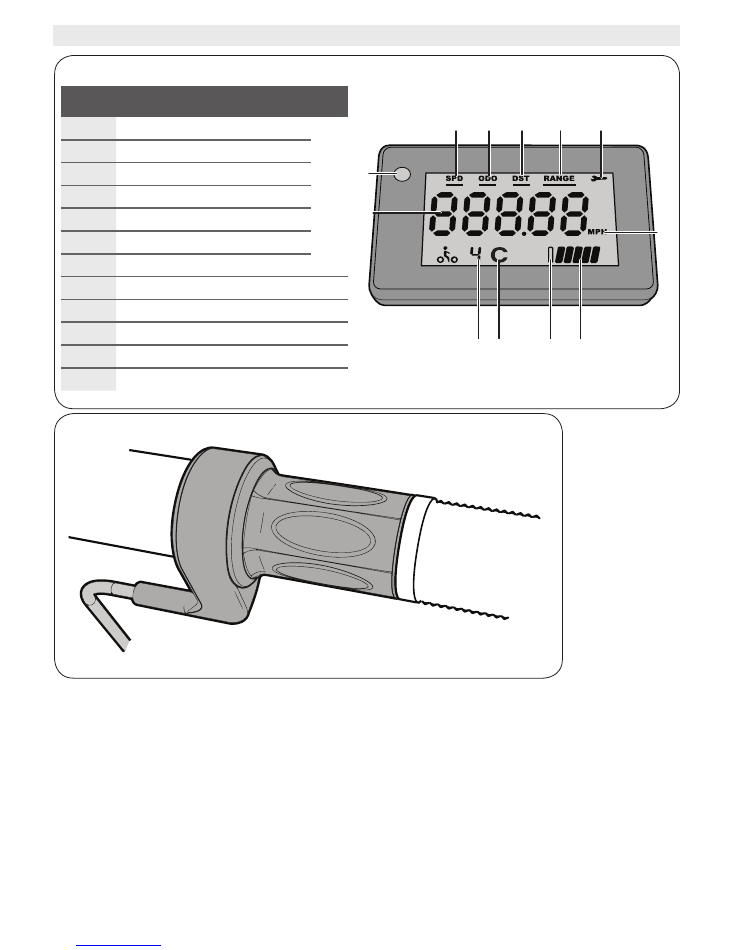
5
/16
System Operation Manual - E3 Path+, Venture, Detour
10/29/14
Throttle
Display
I
K L
C D E
F
G
A
B
DISPLAY FUNCTIONS
A
Ambient light sensor
B
Main display area
C
Speed
D
Odometer
E
Distance
F
Range
G
Maintenance indicator
H
Distance unit
I
Assist level indicator
J
Cruise control indicator
K
Low battery warning indicator
L
Battery level indicator
H
J
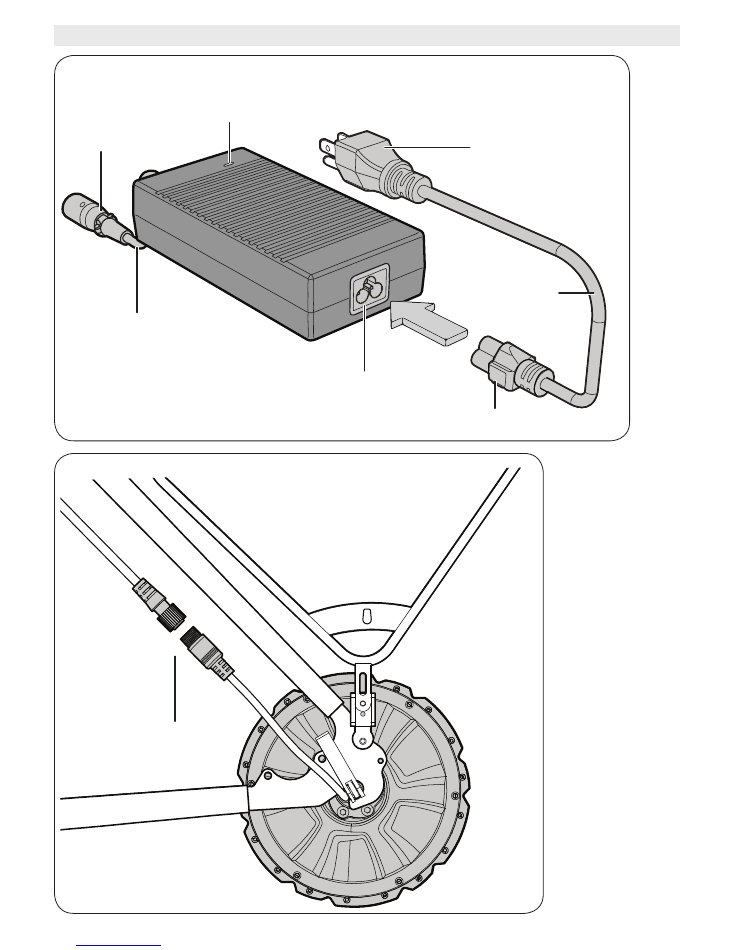
6
/16
System Operation Manual - E3 Path+, Venture, Detour
10/29/14
Rear wheel
Motor connector
Battery charger
Wall plug
Power
cord
Power plug
Power socket
Charging cord
LED indicator
Charging
plug

7
/16
System Operation Manual - E3 Path+, Venture, Detour
10/29/14
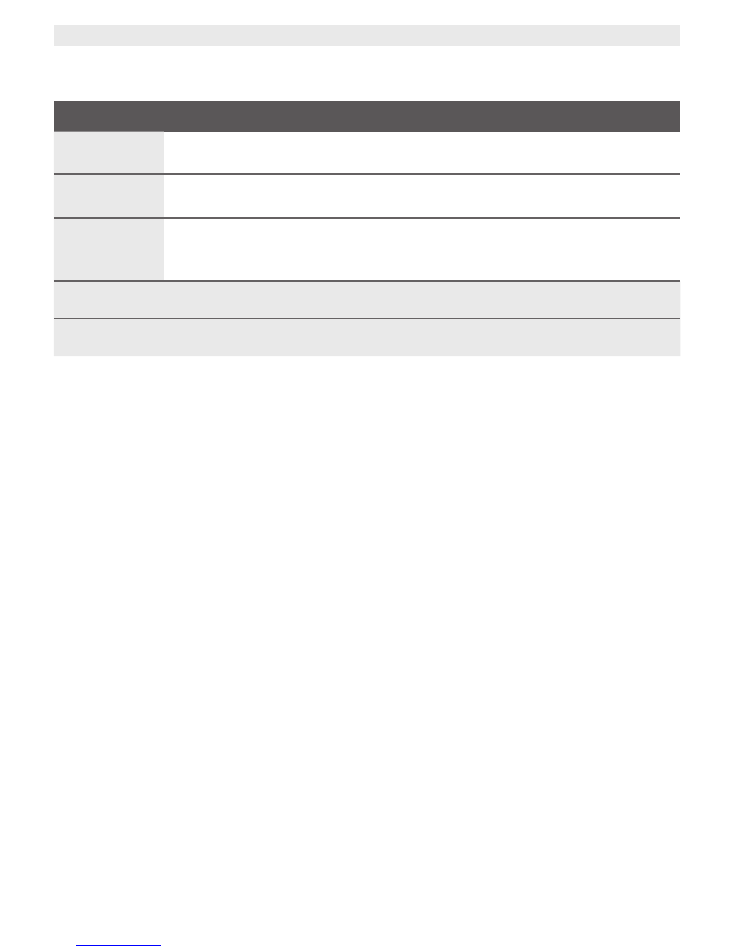
8
/16
System Operation Manual - E3 Path+, Venture, Detour
10/29/14
General information
USE RESTRICTIONS
Intended
Use
1
Condition 2
(General purpose riding)
Minimum
rider age
16 years
Maximum
permissible
weight
2
110 Kg (242 lbs)
1. This bicycle is intended to be used under the guidelines of the stated condition,
found in the intended
use section of your owner’s manual. Be sure to read this section of the owner’s manual for more information.
2. Maximum permissible weight includes the weight of the rider (plus clothing, riding gear, etc), the weight
of any added accessories, and any cargo being carried.
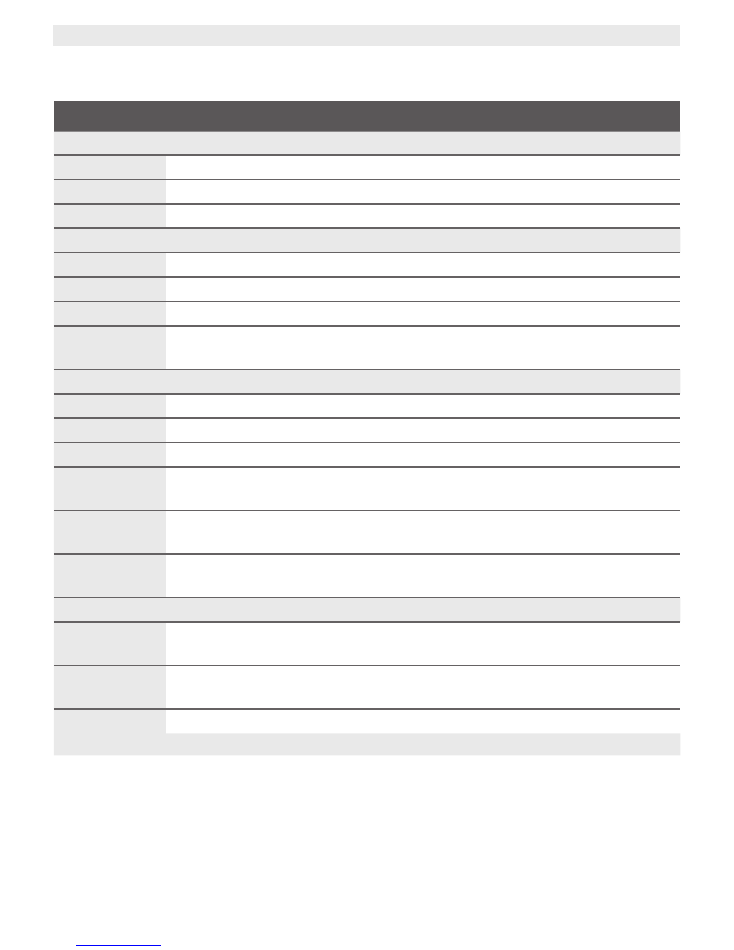
9
/16
System Operation Manual - E3 Path+, Venture, Detour
10/29/14
TECHNICAL SPECIFICATIONS
Motor
Type
Rear hub drive
Rated power
500w
Peak torque
42 Nm
Battery
Voltage
48V nominal
Capacity
8.8Ah
Energy
422Wh
Cycle life
(expected)
~700
Charger
Input voltage
110-240V AC (auto-sensing)
Frequency
50/60Hz
Input current
2.2A maximum
Charging
voltage
54.6V DC (48V nominal)
Charging
current
2.0A
Full charge
duration
4-6 hours
Ride performance
Top assisted
speed
32 km/h (20 mph)
Range
(expected)
1
25-35 miles
Control type
Throttle/pedal assist. Cadence sensor, speed sensor.
1. With normal pedaling; Contingent on terrain, rider weight, riding style, and other factors.
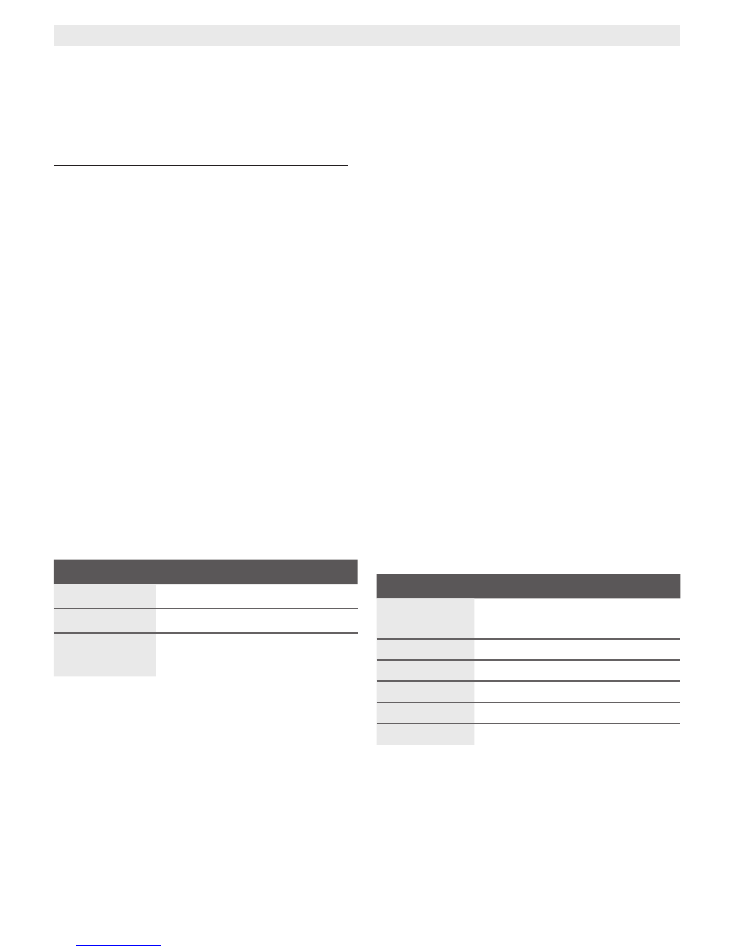
10
/16
System Operation Manual - E3 Path+, Venture, Detour
10/29/14
Basics
IMPORTANT:
The owner’s manual included with your bike contains most of the important
safety and usage information about this bike, which is not included in this system operation
manual. Be sure to read the owner’s manual before you begin riding or working on your bike.
Battery charging
You should charge the battery fully before
riding for the first time, following the instructions
below. Be sure to check the section of your
owner’s manual discussing “Battery care &
safety” for additional information.
Charging procedure
Connect the power cord to the battery
charger. Plug the charging plug into the
battery’s charging port, then plug the wall
plug into a wall outlet.
The charger should always be plugged
first into the battery, then into the wall
outlet.
Charging will begin immediately. The
charger’s LED indicator will light up to show
its status.
LED
STATUS
Red
Charging
Green
Finished charging
Red
(flashing)
Charging error; see
“Charging issues” below
If the battery is attached to the bicycle,
and the bicycle is turned on, the battery level
indicator on the bike’s display will show the
current charge level. See “Turning the bike
on and off” on page 11.
The battery does not have a “memory”. This
means that it can be charged at any time, or
partially charged, without causing damage
or decreasing performance.
Charge time
The amount of time needed to charge the
battery varies based on the battery’s charge
level. A completely empty battery will take
between 4 and 6 hours to charge. A battery
at 50% may only need 2-3 hours to come
to a full charge.
Checking the battery’s charge
level
Before riding, you should check the
battery’s charge level. If the battery is not
fully charged, riding range will be reduced.
To check the battery’s charge level, first
install the battery in the bike, then turn the
bike on (see “Using the battery” on page
11). The battery level indicator on the
display will show the battery’s charge level.
Each bar represents about 20% capacity:
BARS
BATTERY CHARGE
(low battery
warning)
<5%
1
≤20%
2 ~20– 40%
3 ~40 – 60%
4 ~60 – 80%
5 ~80 – 100%

11
/16
System Operation Manual - E3 Path+, Venture, Detour
10/29/14
Using the battery
Installing the battery
First, make sure the battery is unlocked. If needed, unlock the battery by turning the key
45° counter-clockwise until it stops.
Then, slide the battery into the rack from the rear; the end of the battery will be flush with
the battery receiver when fully inserted.
Finally, lock the battery in place by turning the key 45° clockwise.
You must lock the battery before riding the bike. If the battery is unlocked, it could
fall out while you ride.
Removing the battery
To remove the battery, first unlock it, then pull it straight out the back of the rack.
Turning the bike on and off
To turn the bike on...
Press the control pad power button (
). The display will initialize, displaying a countdown
on its screen. During this countdown, the software is self-testing and calibrating the bike’s
sensors. While this countdown is shown, do not step on the pedals. The calibration includes
setting a zero-point for the pedal sensors, and any weight on the pedals will disrupt this
process. After the countdown completes, the bike is ready to ride.
To turn the bike off...
Press the control pad power button (
)
two times. A, for 2 seconds each time. After
the first press, the bike will enter assistance level 0, showing ‘0’ on the display’s assist level
indicator (see “Assist levels” on page 12). After the second press, the bike will turn off and
the display screen will go blank, as will the battery power indicator.

12
/16
System Operation Manual - E3 Path+, Venture, Detour
10/29/14
Riding and use
Be sure to read the “Electric Bikes” section of your owner’s manual, and specifically
pay attention to the sections on “Riding an electric bike” and “Riding a high-speed electric
bicycle” before you ride for the first time.
Getting ready to ride
First turn the bike on, following the
instructions in “Turning the bike on and off”
on page 11 of this manual.
Mount the bicycle. Be sure you don’t
accidentally twist the throttle, or turn the
pedals; this could cause the bike to accelerate
unexpectedly.
Riding the bike
Using the motor
The purpose of the motor is to gently
augment the effort you put into riding the
bike. When you pedal fast, the motor assists
you more; when you pedal slowly, the motor
assists you less.
So, to ride the bike, all you really need
to do is pedal. The majority of the work of
controlling the motor is done automatically.
There are, however, three other controls
that affect how the motor runs: assist levels,
the throttle, and cruise control.
Assist levels
Assist levels control
how much
power the
motor will add to your pedaling. The assist
level is shown on the display, and can be
changed at any time using the
and
buttons on the control pad (see “Control pad
functions” on page 14).
Levels 1–4 are increasing levels of
automatic motor assist. Level 1 gives the
least assistance; level 4 gives the most.
“T”, or “throttle-only” mode disables the
automatic motor assist, but leaves the throttle
active. Simply twist the throttle to control
the motor.
Level 0 disables motor assist completely.
Other functions such as the cyclecomputer
can still be used.
Throttle
The throttle
can be used under certain
conditions to override the automatic assist:
In “T”/throttle-only mode, automatic motor
assist is disabled, and the throttle is always
active.
In assist level 1–4, when moving under
10 km/h (6 mph), the throttle is always
active, even without pedaling. This helps
you get moving from a stop, and helps when
navigating difficult terrain at low speed.
In assist level 1–4, when moving over 10
km/h (6 mph), the throttle is active as long
as you are pedaling.
The throttle is never affected by assist level.
Using the throttle, you always have control
of up to 100% of the motor’s power.
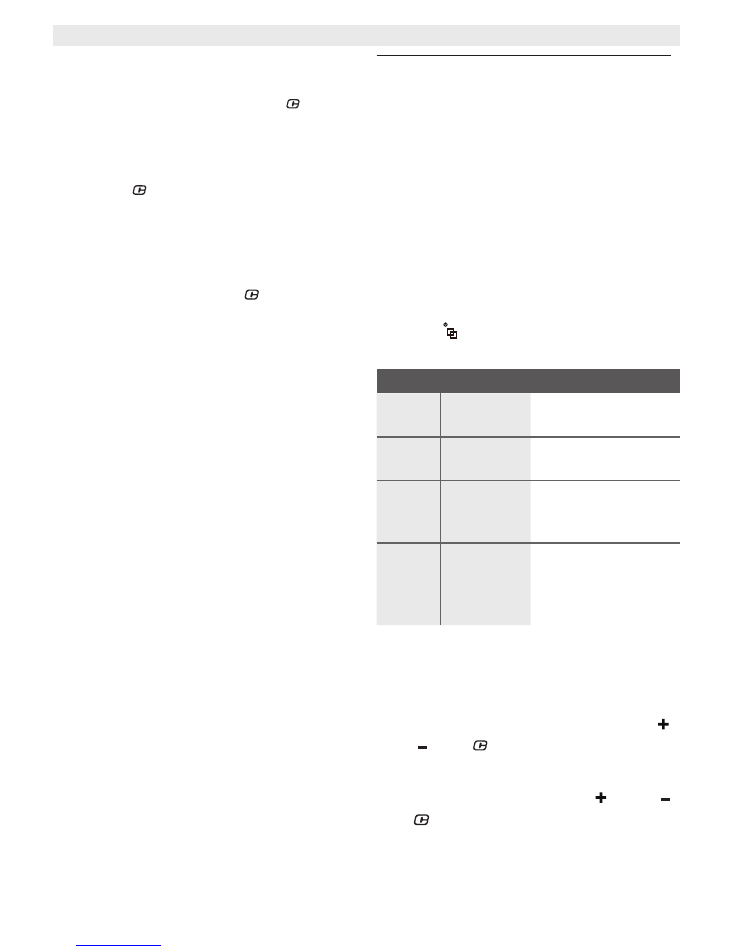
13
/16
System Operation Manual - E3 Path+, Venture, Detour
10/29/14
Cruise control
While in “T”/throttle-only mode, cruise
control can be turned on with the
button:
First, pedal or use the throttle to reach
your desired cruising speed. Hold the throttle
in a position that maintains this speed, and
press the
button. You can then release
the throttle, and the bike will hold its current
speed, plus or minus about 3 km/h (2 mph).
Cruise control can be disabled at any time
by pulling either brake lever, twisting the
throttle, or by pressing the
button again.
Cruise control will not function over 32 km/h
(20 mph). If you turn on cruise control while
traveling faster than 32 km/h, the bike will
decelerate to 32 km/h and hold that speed.
Using the brakes
The brakes are integrated with the electrical
system. When you pull the brakes, they not
only slow the wheel like a normal bicycle
brake, they also cut power from the motor.
See the “Brakes” section of your owner’s
manual for more information.
The display and control
pad
The display serves both as a cyclecomputer,
displaying speed and distance information,
and as an interface to the bike’s electrical
system. The functions of the display are
controlled by the control pad.
The display’s cyclecomputer
functions
The display has four cyclecomputer
functions. Switch between these functions
using the button. The function’s information
is displayed in the main display area.
CYCLECOMPUTER FUNCTIONS
SPD
Speed
The bicycle’s
current speed
ODO
Odometer
The bicycle’s total
mileage
DST
Trip
distance
The distance
covered during the
current trip
Range
Remaining
range
The estimated
remaining range
before the battery
is empty
Distance and range are displayed in the
units shown to the right of the main display
area
.
To reset the trip distance counter, hold
and
and
on the control pad together
for 10 seconds.
To reset the odometer, hold
and
and
on the control pad together for 60
seconds.
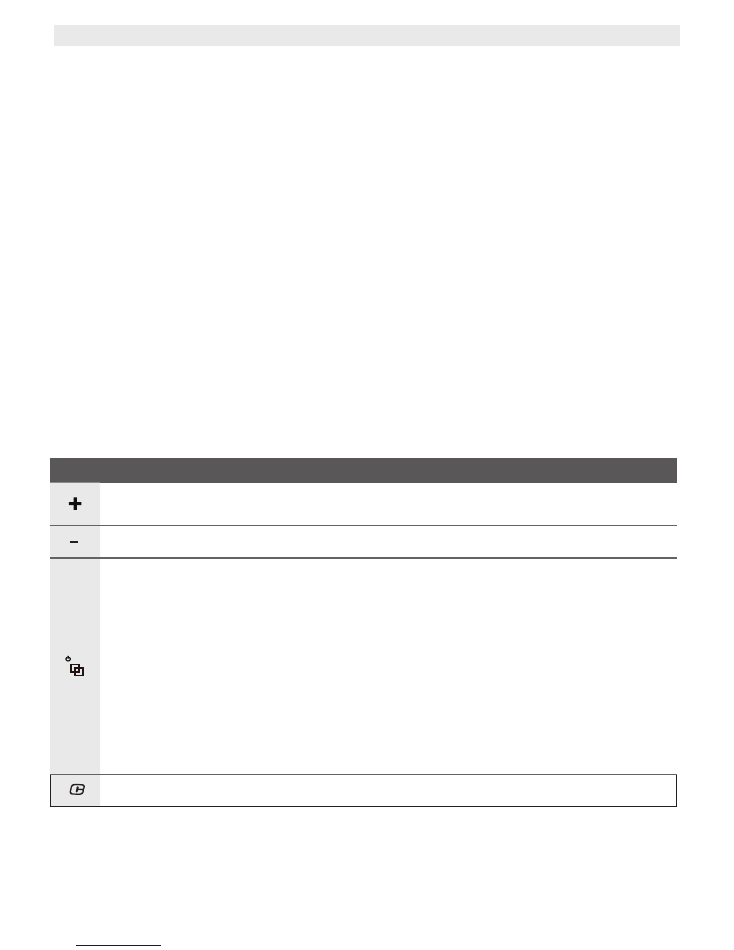
14
/16
System Operation Manual - E3 Path+, Venture, Detour
10/29/14
The display’s electrical system functions
The display shows information about the bike’s electric assist, and gives the rider access
to several important functions:
Assist level
The current assist level is shown on the display (assist level indicator).
Battery level
The battery level indicator shows the current charge level of the battery. Each bar
represents about 20% capacity.
The low battery warning indicator
lights up when the battery has
less than 5%
remaining
charge.
Maintenance information
The maintenance indicator
lights up when there is a system error. An error code shown
on the display helps to diagnose the problem. See “Error codes” below.
Control pad functions
The control pad is used to control the various functions of the bike and display.
The control pad’s four buttons perform the following functions:
CONTROL PAD FUNCTIONS
Increase assist level (1–4), or to switch to throttle pure mode “T”.
Hold 2 seconds for backlight (and light set if installed).
Decrease assist level (4-1).
Turn bike on, one quick press
(turn on battery first, p.4)
Change cyclecomputer display, quick presses to cycle through the options
(after bike is on)
Set power assist to 0, one 2 second press
(no pedal or throttle assistance, just power for the display)
Turn power off, one 2 second press
(must be in assist level 0 first)
Activate cruise control.
The display backlight and any attached headlight/taillight is also controlled by the ambient
light sensor; they will automatically turn on in low light.
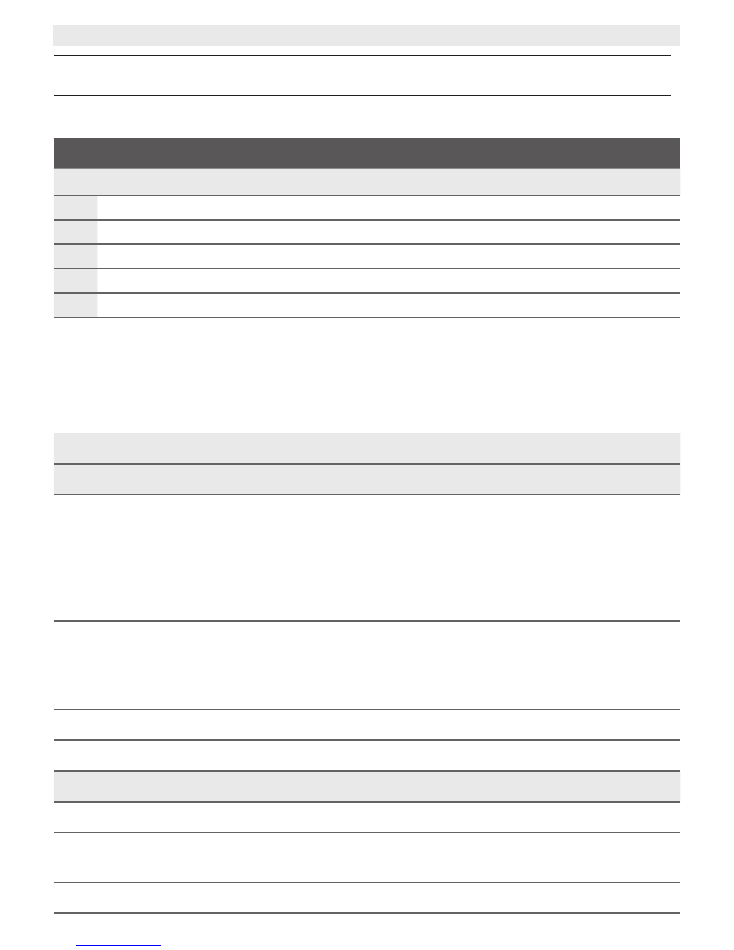
15
/16
System Operation Manual - E3 Path+, Venture, Detour
10/29/14
Troubleshooting
Error codes
SYSTEM ERROR CODES
In the event of a system error, these codes will appear on the display.
1
Motor internal error
4
Cadence sensor error
5
Motor speed sensor malfunction
6
Brake lever cut-off sensor malfunction
7
Throttle malfunction
Most of the time, these errors can be resolved easily by checking the wiring connections
for the affected component. Call EBCC customer service, or see your dealer for more
information.
Charging issues
ISSUE:
Charger LED indicator flashes red
LED flashes red after charging for a while:
Battery is not responding to charging.
• The battery voltage is less than 25V, and does not rise above 25V after 30 minutes
of charging.
• The battery voltage is between 25V and 30V, and does not rise above 30V after one
hour of charging.
Solution
Reset charging by unplugging the charger from the wall outlet, then
plugging it back in. If charging fails after a second attempt, the battery
or charger may need to be replaced. Bring them to your dealer for
inspection.
Battery has not finished charging after 10 hours.
Solution
The battery may be damaged and should be inspected by your dealer.
LED flashes red immediately after being plugged in:
The polarity between the charger and battery does not match.
Solution
The battery or charger may be damaged. Stop using the battery and
charger immediately, and bring them to your dealer for inspection.
The output of the charger is short-circuited.
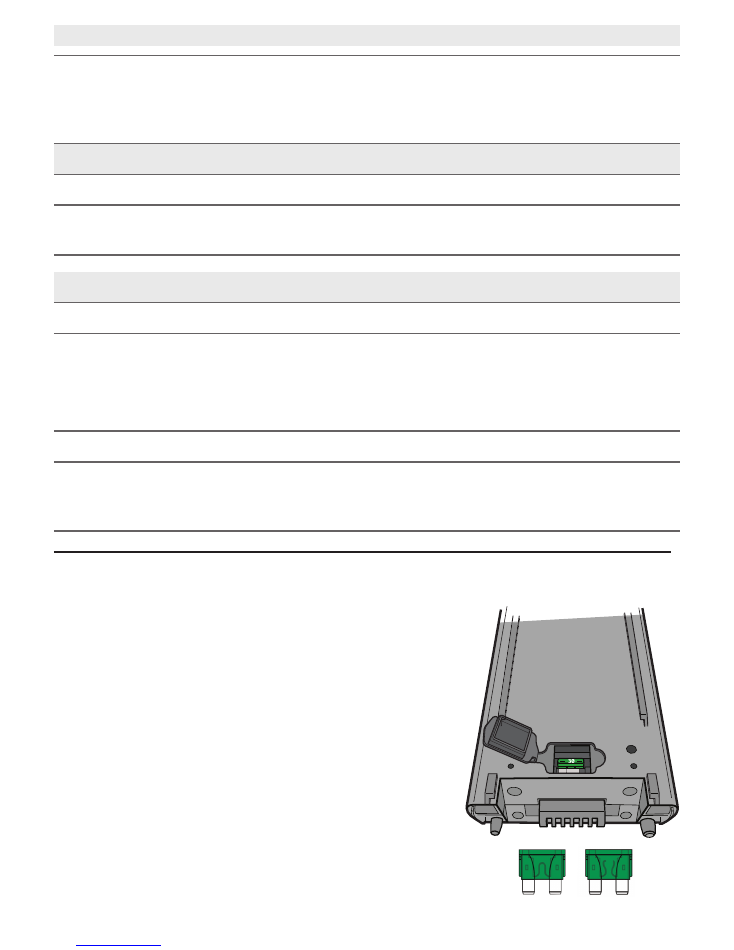
16
/16
System Operation Manual - E3 Path+, Venture, Detour
10/29/14
Solution
Stop using the battery and charger immediately. Check for obvious
external shorts on the charging plug and battery charging port. If no
obvious short exists, the battery or charger may be damaged. Bring
them to your dealer for inspection.
Other issues causing a flashing red LED:
The temperature of the battery is too high to charge.
Solution
Put the battery and charger in a cool place, then try charging again
after a few minutes.
ISSUE:
Charger LED indicator
stays green when plugged into the battery.
There is no connection between the charger and the battery.
Solution
Check for damage: battery charging port, charging plug, charging
cord, and power cord
.
There may be an internal problem with the battery or charger. Bring
them to your dealer for inspection.
The battery’s voltage is too low to be charged.
Solution
Check the battery’s charge level as described in this document. If the
battery will not turn on, the battery may be damaged and should be
inspected by your dealer.
Misc issues
Lost key
If you have lost your keys, note your bike’s serial number
(
located underneath the frame’s bottom bracket
) then call
EBCC customer service at (800) 377-4532.
No power from battery
The battery has a user-replaceable fuse located at its
base. The fuse is not installed at the factory; you must
install it before using the bike for the first time.
If the fuse is present but the bike still does not power up,
inspect the fuse; if it is blown out, it can be replaced with
a standard 30-amp automotive fuse.
Good Blown
M19+貨架電池+RPM